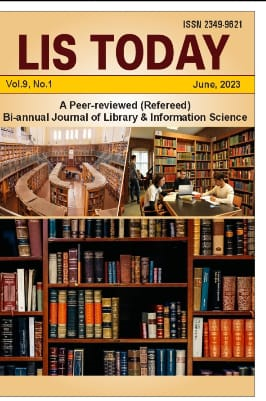Awareness of Plagiarism among the Students and Research Scholars of Delhi University (DU) and Jawaharlal Nehru University (JNU): A Comparative Study
Keywords:
Plagiarism, Anti-Plagiarism Software, Academic Dishonesty, Copyright, University Library, User AwarenessAbstract
Plagiarism is a massive issue in today’s academic field due to the information overflow. It can be noticeable at every level of the academic career. Many academicians take shortcuts when working, which leads them to use plagiarism because they are unaware of plagiarism, do not want to break the copy-and-paste culture or are pressed for time. Plagiarism is when someone takes someone else's work and passes them off as their own. Plagiarism is strongly linked to forgery and piracy, both of which are illegal under copyright laws. This is a significant problem for university students and research scientists; everyone must be extremely cautious with their academic work to solve it.This study shows the awareness of plagiarism among the students of two renowned universities in Delhi. It also shows the reason behind the adoption of plagiarism.A quantitative survey was conducted in Delhi with a sample of 100 students from Delhi University (DU) and Jawaharlal Nehru University (JNU). The first main finding of the report is that the reasons for plagiarism are a lack of willingness to study and a copy-paste culture. Second, most students learn about plagiarism through lecturers or other sources like web sources. Nowadays, plagiarism has become a punishable offence, so we need to be extra careful about plagiarism.
References
Abad-Garcia, M. (2019). Plagiarism and predatory. A threat to scientific integrity, 90, 57.e1- 57.e8.
∙ Ariail, D. L., Frank J. C, & Sandra V.S. (2015).Academic dishonesty in an accounting ethics Class: A case study in plagiarism. Journal of the International Academy for Case Studies,21(5),5-6.https://search.proquest.com/docview/1768629359?accountid=10 461
∙ Chandere, V., Satish, S. &Lakshminarayanan, R. (2021). Online Plagiarism Detection Tools in the Digital Age: A Review. Annals of the Romanian Society for Cell Biology, 25(1), 7110– 7119.https://www.annalsofrscb.ro/index.php/journal /article/view/881
∙ Chitra, A., &Anupriya R.(2016). Plagiarism Detection using Machine Learning-Based Paraphrase Recognizer.Journal of Intelligent Systems,25(3),351-359.https://search.proquest. com/docview/1861880867?accountid=10461
∙ Dalal, N.(2016). Exploring Reflective Means to Handle Plagiarism.Journal ofInformation Systems Education, 27(3), 175-181. https://search.proquest.com/docview/192 8985987?accountid=10461
∙ Eisa, T.A. E., Naomie S., &Salha A.(2015). Existing Plagiarism Detection Techniques.Online Information Review,39(3), 383- 400.https://search.proquest.com/docview/16860548 36?accountid=10461
∙ He, F., et al. (2016). Necessary Evil: Assessing Full-Time Vs. Part-Time Student Perceptions of Plagiarism. Allied Academies International Conference. Academy of Organizational Culture, Communications and Conflict Proceedings, 21(1), 23-27.https://search. proquest.com/docview/1787916643?accountid=10461
∙ Jereb, E., Perc, M., Lammlein, B., Jerebic J., &Urh, M. (2018). Factors influencing plagiarism in higher education: A comparison of German and Slovene students. PLOS ONE 13(8): e0202252. https://doi.org/10.1371/journal.pone.0202252
∙ Kumari, P., & Lakshmi, S. (2015). Awareness on plagiarism among research scholars of Sri Venkateswara University: A study. IOSR Journal of humanities and social science (IOSR JHSS), 20(3), 55-59. Retrieved from www.iosrjournals.org
∙ Lei, J., &Guangwei, H.(2015). Chinese University EFL Teachers' Perceptions of Plagiarism.Higher Education, 70(3), 551-
565.https://search.proquest.com/docview/1704934537? accountid=10461
∙ Oyewole, O., Rasheed, A. A., &Ogunsina, S. T. (2018). Awareness, perception, and attitude towards plagiarism by distance learners in the university of Ibadan, Nigeria. International journal of academic library and information science, 6(4), 101-113. http://www.acad emicresearchjournals.org/IJALIS/Index.htm
∙ Perkins, M., Ulas, B.G.,& Roe, J. (2020). Reducing plagiarism through academic misconduct education. International Journal forEducational integrity, 16(1), 1-15
https://DOI:10.1007/s40979-020-00052-8
∙ Schnall, S.(2013). Schools Aim to Minimize Plagiarism from the Start. Crain's ClevelanBusiness,34(23),15, https://search.proquest.com/docview/1369421998? accountid=10461.
∙ Stowe, S. (2017). Will They Or Not? Online Faculty Intentions to Report Student Plagiarism. Academy of Educational Leadership Journal, 21(1), 1-17. https://search.proquest. com/docview/1987371062?accountid=10461
∙ Tabirca, A., &Valentin R.(2015).Ways to detect plagiarism in academic research. Annales Universitatis apulensis: series Oeconmica, 17(2), 76-87.https://search.Proquest.com/ docview/1827600279?accountid=10461
∙ Thomas, A.(2017). Faculty Reluctance to Report Student Plagiarism: A Case Study. African Journal of Business Ethics, 11(1). https://search.proquest.com/docview/2008461861? accountid=10461

